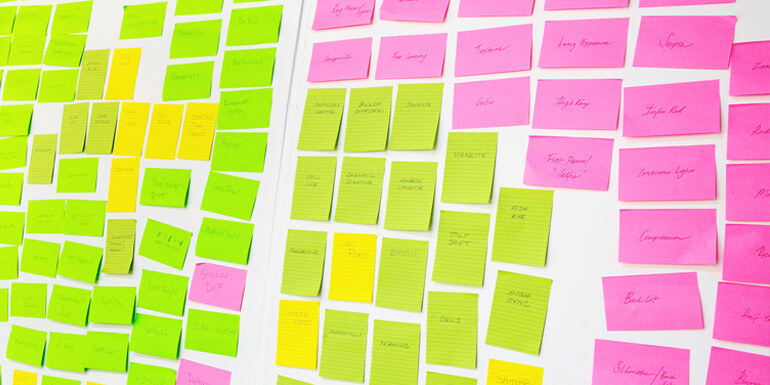How to map your customer's journey
With customers expecting brands to understand their preferences, wants and needs, customer experience (CX) is often at the forefront of a company’s strategy. Using customer journey mapping as a planning tool is an ideal starting point for understanding your customer's perspective.

What is a customer journey map?
A customer journey map is a visual or graphic interpretation of an individual's perspective of their entire journey and relationship with an organisation, service, product or brand.
It combines storytelling and visualisation to convey a holistic end-to-end customer experience (CX) in a way that is memorable, concise, and that creates a shared vision.
Why do you need customer journey maps?
Understanding how your product, service or overall brand fits into your customers' lives is crucial, yet companies rarely sit down to piece together the entire CX. A customer journey map does precisely this and below is a breakdown of some of its benefits:
- It shifts a company's perspective from inside-out to outside-in. Being an end-to-end representation of CX, a customer journey map refocuses the company's culture on the thoughts, actions and emotions of customers.
- It provides context for project work. Having the map throughout a project will ensure that marketers, designers and copywriters are continually considering the customer's perspective and how their feelings and goals will change as they move through the journey.
- It facilitates both current and future state visioning. As well as reviewing existing processes, customer journey maps can be used to pinpoint opportunities to improve CX and areas where there are risks of dissatisfying customers.
- It facilitates making more educated moves, less guesswork. When a company maps out how their customers interact with a brand, designers can identify the gaps between channels and copywriters can understand what questions or expectations the customers have.
- It encourages cross-departmental collaboration. Customer journey maps are multi-disciplinary. This means they can be used to break down silos and bring different departments together with a shared vision of enhancing CX.
- Its utility extends beyond customer-facing employees. It’s easy to see how front-end employees benefit from customer-centric information. However, back-end employees also benefit from obtaining a detailed view of how their specific tasks contribute to either positive or negative CX.
How do you create a customer journey map?
While there are some useful guides, there is no right or wrong way to create a customer journey map. Usually, it will end up being a tabulated grid or infographic with a visual timeline of the customer's experience.
Step 1. Do your research
The process of creating a customer journey map begins with getting to know your customers. The whole idea of a customer journey map is drawn upon what customers do, think, feel, and how they interact with your company.
Research methods such as customer interviews, customer surveys, customer support/complaint logs, web analytics, social media statistics, and competitive intelligence all provide distinct information about your customers. Using both qualitative and quantitative data will allow companies to gain valuable insights into the customer's journey.
Step 2. Choose a customer persona
Whose journey are you mapping out? The customer journey map needs to be created from the perspective of a 'typical' person from a specific customer group or segment.
This is most effectively represented by building a 'customer persona' that represents the segment. For example, you may begin with 'professional females in their 30s' and then proceed to elaborate on that persona's unique wants, needs, and objectives.
Someone looking into the customer journey map should be able to ascertain which segment or persona's journey is being mapped. Importantly, the chosen persona should help with focusing and defining the scope of the map and will provide context for the next steps.
Step 3. Break down the stages of the customer journey
Once you've decided on a persona, you can begin laying out the skeleton of your customer journey map.
The stages of a customer's journey should be tailored depending on the specific company and project. For example, for an E-commerce store, the stages may be:
- Ads/Discovery
- Awareness
- Desire
- Research
- Choosing
- Purchase/Buy
- Delivery
- Usage
- Feedback (Positive/Negative)
- Support/Help
- Upgrade/Repair
- Renew/Repeat purchase/Continue subscription
When defining the stages of the customer journey, you should generate a list of the customer touchpoints (interactions with the company) and which channels each touchpoint occurs on (including in-store, through apps, online and over the phone). Some of these touchpoints, called 'moments of truth', are more central than others - identifying these will help flesh out the key stages of the customer journey.
Step 4. Generate questions for each stage
Now that you have the stages set out as the skeleton of your customer journey map, you need to come up with a series of questions for each step of the customer journey. The goal is to ensure that the customer's perspective remains front and centre in people's minds, so try to explore their actions, mindsets, and emotions.
Some right questions may be:
- What is the customer doing, thinking, and feeling at this specific stage?
- What questions does the customer have?
- How is the customer interacting with your brand at this touchpoint?
- Are there any gaps when the customer is transitioning between stages?
Step 5. Fill in the finer details
Start general and then narrow down to the finer details. To make your map actionable, it should identify both positive and negative customer emotions throughout their journey and put them in the context of customer behaviours, goals, and expectations. Remember, your chosen persona, coupled with the quantitative and qualitative research you gathered in Step 1, should be your paramount guide.
Tips and reminders
- The aim is not to map out every nuance of a customer experience. It's crucial to capture as best you can every step of the customer journey; however, bear in mind that too many stages will make your map too complicated and impractical.
- Use examples as inspiration, not as templates. Your customer journey map can take any form you wish and be as simple or detailed as you want. It all depends on the context and your business goals.
- The most valuable research comes from your customers. They can help break down the stages from a first-hand point of view, confirm their feelings and which touchpoints they found most useful. It may also be helpful to obtain some insights from employees who interact with customers often, such as customer support representatives.
- Each persona can warrant its map. Different customer segments have different goals, expectations, emotions and journeys. Trying to reflect all customer segments within a single generalised persona will mean that you miss important nuances and insights.
- Have the right mix of people involved in the creation process. Part of the value behind the map comes from the process of creating it. When an employee contributes to the creation, it pushes them to think deeply about the customer's perspective and how to improve CX.
- Get creative. Consider enlisting the help of a designer who can transform the journey map sketch into a visually appealing resource. This will ensure it is as clear as possible and grabs people's attention.
- Journey mapping should not be a one-off activity. Maps should be reviewed frequently to keep up-to-date with shifting customer expectations, and new information obtained as your business grows.
I've created my customer journey. What now?
While customer journey maps end up as tangible deliverables, the real benefits come from referring to it over time. Once your map is finalised, ensure that it is always visible and referenced often.
Initially, this may require you to make a conscious effort to reference the customer journey map in discussions and meetings. As well as customer-facing employees, it is essential to teach back-end employees how the map relates to their role and how to utilise it, particularly with the growing focus on service design.
The goal is to make it a habit amongst the company as a whole to refer to and make use of the customer journey map, and it's easiest to foster this commitment from the outset.





